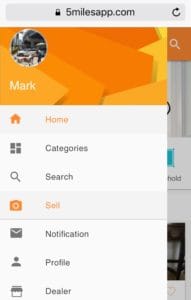Peer-to-peer marketplace 5miles is all about its app.
Since its launch in January 2015, the online marketplace has amassed 11 million app downloads, says Lucas Lu, CEO and founder. The Android app continually ranks in the top 25 most-downloaded shopping apps and frequently ranks in the top-10 most used Android shopping apps, according to digital analytics firm SimilarWeb. Plus, app users account for about 70% of the marketplaces’s total users, Lu says.
But that doesn’t mean that 5miles can ignore its non-app users. In March, about 840,000 consumers visited 5miles’ website, 69% via mobile device and 31% on desktops, according to SimilarWeb. Plus, a good web experience is paramount to attaining app users; a consumer won’t download an app if she doesn’t like the website, Lu says.
To cater more to its mobile web users, Lu decided to update 5mile’s mobile website to use Google Inc.’s latest mobile website technology, progressive web apps.
PWAs promise to have the look and customer engagement of an app but they work on a mobile website. For example, progressive web apps allow retailers to send web push notifications to a shopper’s smartphone, let shoppers add an icon for that retailer’s site to their smartphone home screen without having to download the app, and PWAs are typically much faster than traditional mobile websites.
“A [progressive web app] is for your customers who are not so active but still want to use your services,” Lu says.
Lu is not naive to the realities of apps: Consumers delete them. Shoppers may delete the 5miles app for various reasons. A consumer may have used it to sell her furniture and now she doesn’t need it anymore, the app takes up too much space on her smartphone or she receives too many messages from the app, Lu says. Those users, however, may still want to use 5miles in the future, just on the web, he says.
“A lot of people are searching on Google, click from Facebook and jump to another place, and so by chance come to 5miles,” Lu says. “We want them to use the website and have it be as good as the app.”
5miles’ team of 40 developers coded the progressive web app and migrated its mobile site over to the PWA in about one month, Lu says. A progressive web app uses responsive techniques that format the web page to the size of the screen the consumer is viewing it on. It can be coded to have the same URL as the desktop and tablet site or it can operate on a separate URL, like a stand-alone mobile site.
The 5miles PWA launched in May 2016 and Lu says he is pleased with the results so far. Shoppers spend 20% more time on the PWA mobile site than they did on the previous mobile site, and on average are looking at seven products per visit, compared with viewing five products per web visit previously, Lu says.
 In addition, 5miles’ mobile conversion rate increased, although Lu declines to say how much. The marketplace’s mobile bounce rate also decreased to 25% on mobile devices from about 45% prior to the update, he says. Bounce rate is the percentage of visitors to a site who navigate away from it after viewing only one page.
In addition, 5miles’ mobile conversion rate increased, although Lu declines to say how much. The marketplace’s mobile bounce rate also decreased to 25% on mobile devices from about 45% prior to the update, he says. Bounce rate is the percentage of visitors to a site who navigate away from it after viewing only one page.
Two progressive web app features that the marketplace’s previous mobile site didn’t have are live chat and a function that allows a consumer to upload a picture of a product she is trying to sell. The marketplace also is experimenting with such progressive web app features as web push notifications and asking consumers to share their location.
The web push notification tool is an opt-in feature that allows the marketplace to send an alert to the consumer’s smartphone, even if she doesn’t have the app. 5miles is A/B testing the best time to ask a consumer to opt in to the notifications in order for her to tap yes. For example, 5miles is asking some users right away to opt in and prompting other users after they view one or two product pages.
Two engineers and a project manager are dedicated to maintaining the PWA. Upgrades usually involve calling in other members of 5miles’ developer team, such as designers and user experience employees. Google continually rolls out new features for the technology, so the marketplace keeps an eye on what’s happening and determine if the features would be useful for them. For these reasons, Lu says the cost for maintaining a PWA is higher than what it would be for a mobile website. However, it is cheaper to develop a PWA than a traditional app, because the PWA can build on the website code it already has and does not require coding an app from scratch, he says.
5miles processed $2.58 billion in gross merchandise value in 2016, a 158% increase from $1 billion in 2015, Lu says. In March, the marketplace processed more than $250 million in transactions. 5miles does not take a cut of each transaction but makes money from sellers who pay to have their items listed at the top of the feed or high in search results.
Consumers can choose to complete a transaction offline in cash, which is typical for most peer-to-peer marketplaces. Consumers also can transact in-app, in which case 5miles charges a 4.9% transaction fee. 5miles has raised $50 million in funding.
Favorite